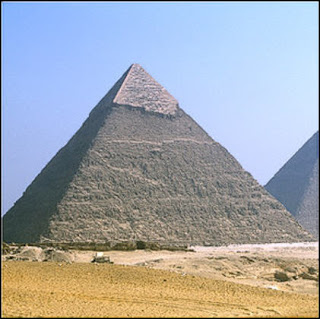Sneferu who founded the Fourth Dynasty, is best known to us today for his prodigious building program. The so-called “Collapsed Pyramid” or “Ruined Pyramid” at Meidum is thought by many Egyptologists to be his first building project. Originally, the Meidum pyramid was a step pyramid, but it appears that Sneferu later ordered the steps to be “filled”, an attempt at building a true pyramid.
The Great Pyramid
A somewhat disputed theory is that the pyramid actually collapsed catastrophically and the mound of rubble around the base is what remains, but no bodies, scaffolding, tools, or the like have ever been found in the mound. The more widely accepted theory is that the pyramid was “quarried” for stone in later times; indeed, the Arabic writers of the 1100s CE report that the pyramid had five steps, while today it has only three. Sneferu also built two pyramids at Dahshur, not far from Meidum, and these were planned as true pyramids from the start. The first is known as the “Bent Pyramid” owing to the way its slope angle changes partway up from 55 to about 43. This change is believed to be due to subsidence that was noticed while the pyramid was still being built; the accurate cutting and laying of the blocks was not yet what would be seen at Giza. The second, and the first successful true pyramid, is the North Dahshur Pyramid or “Red Pyramid”, so called for the red color of its sandstone blocks in the sun, and built entirely at the “safer” reduced slope. Sneferu’s son Khufu is even more famous; the Great Pyramid at Giza was built for him. The largest pyramid ever built, it contains millions (estimates vary from two to four million) blocks of sandstone,7 most of them weighing more than two tons apiece. Several smaller “satellite” pyramids were built in its shadow, most likely for Khufu’s wives. Two large boats were also buried in pits adjacent to the pyramid, and were discovered in the 20th Century. The boats are believed to have been used to transport the royal mummy and funeral goods up the Nile at the time of the burial. While there is much controversy regarding the purpose and technique of pyramid construction, no more satisfactory hypotheses have been proposed than the traditional ones: that the pyramids were built as monuments and tombs for the pharaohs, and were accomplished using systems of ramps, levers, and rollers which were simple in principle but sophisticated in planning and execution. Khufu’s successors added to the monumental complex on the Giza plateau. Khafre built the second-largest pyramid, an associated funerary temple, and (according to most Egyptologists) the Great Sphinx. Khafre’s pyramid is the central of the three great ones at Giza, and appears in most photographs to be larger than Khufu’s because it stands on bedrock some ten meters higher than Khufu’s, while the pyramid itself is less than three meters shorter. Khafre is perhaps even better known, however, as the builder of the Great Sphinx. The Sphinx’s head is carved to a scale of 30:1—unprecedented in Egyptian art, and not to be repeated until the New Kingdom. Menkaure added the third pyramid at Giza, and a number of larger than life size statues of Menkaure, his wife, and various goddesses, of surpassing quality, were found at the pyramid. The remaining pharaohs of the Old Kingdom continued building pyramids in Lower and Middle Egypt, and presiding over the solar religion which characterized the period. However, for unknown reasons, Menkaure’s immediate successor Shepseskaf returned to Saqqara for his tomb and built a gigantic mastaba, known today as the Mastaba el-Fara‘un, instead of a pyramid.

